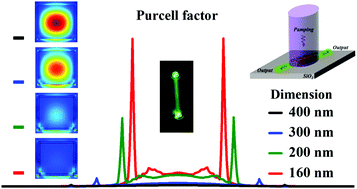Metallic cavity nanolasers at the visible wavelength based on in situ solution-grown Au-coated perovskite nanowires†
Abstract
Metallic cavities have been recognized as promising structures for realizing subwavelength nanolasers, as the mode volumes are considerably smaller than the optical diffraction limit. However, current nanolasers based on metallic cavities have only been realized in the near-infrared range, since high optical loss from the metal makes metallic lasing in the visible-wavelength region challenging. Here, we propose an innovative approach to fabricate a metallic-cavity-based plasmonic nanolaser based on Au-coated perovskite nanowires synthesized via an in situ solution method. The intrinsic ohmic loss of the metal could be overcome by the high gain of the perovskite. The laser presents prominent lasing behavior at the visible wavelength of 548 nm. The mode area is reduced to λ2/48, the Purcell factor reaches 108, and the physical dimensions are only 150 nm. Notably, competition between plasmonic modes and photonic modes was observed for the first time in a metallic cavity nanolaser. This work can promote the application of perovskite composite nanostructures in photonic devices.



 Please wait while we load your content...
Please wait while we load your content...